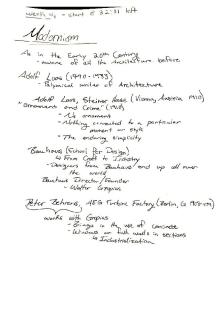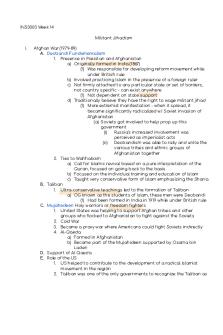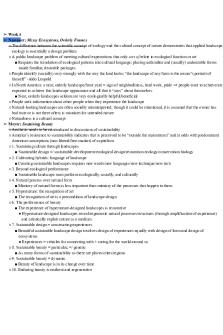Equity Notes week 1-4 PDF

| Title | Equity Notes week 1-4 |
|---|---|
| Course | Equity and Trusts |
| Institution | Macquarie University |
| Pages | 85 |
| File Size | 1.9 MB |
| File Type | |
| Total Downloads | 8 |
| Total Views | 131 |
Summary
Lecture notes from week 1 - 4. Includes tutorial questions but no answers....
Description
Equity Notes Week 1 Lecture 1-3 1 History of Equity In this lecture we will 1. Try to define what equity is why does it exist; 2. Then we will look at its history and evolution, and the relationship between law and equity and why equity works the way it does; 3. Look at the debates surrounding the fusion of law and equity; 4. What are the contemporary purposes of equity; 5. How equitable interests and estates are created. What is Equity •
Variety of meanings
•
Lay person understanding
•
Despite terminology is not synonymous with ‘fairness’ in the broad sense:
“Since the time of Lord Eldon, the system of equity for good or evil has been a very precise one, and the equitable jurisdiction is exercised only on well known principles.” Bridge v Campbell Discount Co Ltd [1962] AC 600, 626. •
Matters giving rise to ‘an equity’
•
Branch of law established and exercised by the English Court of Chancery, prior to the Judicature Act 1875.
•
“In the most general sense, equity means fairness in the resolution of disputes through the application of good conscience. In Anglo-Australian law, however, equity has a specific and unique meaning. It can be described as that body of law that, before the Judicature Acts of 1873 – 1875, was administered in England by the Court of chancery and was received and administered in the Australian Courts.” Dal Pont
•
“Equity is a roguish thing. For law we have measure…equity is according to the conscience of him that is Chancellor, and as that is longer or narrower, so is equity. ‘Tis all one as if they should make the standard for the measure a Chancellor’s foot” - John Seldon
•
what is ‘conscience’ or unconscionable conduct?
•
“The element which both attracts the jurisdiction of the court of equity and shapes the remedy to be given is unconscionable conduct on the part of the
person bound by the equity and the remedy required to satisfy an equity varies according to the circumstances of the case” •
Walton Stores (Interstate) Ltd v Maher (1988) 164 CLR 387 (Brennan J)
The Role or Purpose of Equity •
“… equity … qualifies, moderates and reforms the rigour, harshness and edge of the law. [T]he office of equity [is] to support and protect the common law from shifts and crafty contrivances against the justice and the law. Equity therefore does not destroy the law, nor create it, but assist it.”
Dudley v. Dudley (1705) 24 ER 118, 119 (Lord Cowper). •
Which sort of begs the question, why did we need something that moderates the common law?
Lets go back to 1066… •
Norman invasion of England by Normans in 1066 – Battle of Hastings
•
Introduction of the feudal system and subinfeudation.
•
Brought increased administration and record keeping – Domesday book.
•
Local customary law – ‘common law’
•
Ecclesiastical courts – the role of granting probate and distribution of personal property, cf real property
•
Commencement of a common law action via a writ
•
Inflexibility of the writ system The application of strict rules Limited causes of action Limited remedies Jurisdiction corruption
Petitions to the Chancellor •
The Chancellor’s discretion – relief given or withheld not according to precedent, but his individual sense of right and wrong.
•
Claimant had to show: Could not receive justice in CL courts ‘clean hands’ No delay in bringing action
History of Equity - the development of the trust
•
Grew out of necessity
•
Rules relating to property – devised to the eldest son
•
People wanting to avoid the legal rules conveyed land to be held on ‘use’
•
This deprived the King of income, and Henry VIII was successful in persuading parliament to pass the Statute of Uses. However, this caused significant social upheaval – Statute of Wills.
History of Equity – a Court of Conscience •
The role of religion in medieval England had a particular bearing on the development of the equitable jurisdiction.
•
The Chancellors drew on the principles that the Church had taught them, and required the litigants to act in accordance with what the Chancellor saw as their religious duty. Their religious duty was to act in accordance with God’s will.
•
The medieval ‘conscience’ - synderisis
The History of Equity – the common injunction •
It was important the Chancery did not seek to controvert or upset a judgment that was given at common law. Rather, it enquired whether, by reason of circumstances that were not taken into account in the judgment, it was against conscience to enforce it.
•
A brings a CL action against B for ejectment due to non-payment of rent;
•
B claims that there was an arrangement between A + B to suspend payment of rent;
•
A claims that there was no consideration = agreement not valid (under CL/Contract Law principles);
•
B claims that there is an equity that estops A from acting otherwise than the latter agreement;
•
A seeks to have his legal rights at CL enforced;
But in Equity: the agreement between A and B gives right to an equity = B can get “common injunction” = prevent A from bringing proceedings at law which would contradict the estoppel proceedings (if A disobeys = imprisonment for contempt) The Equitable Jurisdiction •
Concurrent – where common law is deficient ie remedies
•
Exclusive – whether common law does not recognise an obligation ie fiduciary duty, trust
•
Auxiliary – procedural or interlocutory assistance ie issuing subpoenas.
Lecture 2 History of Equity Last lecture we looked at the conditions in England that gave rise to the genesis of the equitable jurisdiction. These include: •
The nature of the common law
•
The nature of landholding and court structures
•
The divisions and responsibilities of decision making bodies
This lecture will continue to look at how the political landscape impacted the continued evolution of equity, and how the changes brought about by the Judicature Acts not only restructured the legal processes, but gave rise to more debate about the operation and functions of equity. •
Changes to the operation of the Chancery court in the 17 th C were closely connected with the powers of the King and the Parliament.
•
James I felt that as maker of the law he was above it. This contrasted to the views held by medieval England and in particular Sir Edward Coke.
•
The tensions between the common law and equitable jurisdictions grew – common law judges being particularly upset at having the ‘common injunction’ imposed on their rulings.
•
Matters came to a head in the Earl of Oxfords case 1615
•
Coke:
•
“If one doth disseise me of land, and builds a house upon this land, I shall have a judgement for this; and he shall not go into the Chancery to be relieved for this; no more shall he do so in this case, for in such cases the rule of law is this, caveat emptor”.
•
Sir Francis Bacon:
“we…command…that our Chancellor, or Keeper of the Great Seal for the Time Being, shall not hereafter desist to give unto our Subjects, upon their several complaints now or hereafter to be made, such Relief in Equity (notwithstanding and Proceedings at the Common Law against them) as shall stand with the Merit and Justice of their Cause.” The Judicature Act 1873-1875 These Acts consolidated the existing courts of Common Pleas, Queens Bench, chequer and Chancery into one Supreme Court of Judicature which was enabled to base its cisions on both law and equity. The court was separated into separate divisions but the Act ovided that where there was a conflict, then the rules of equity were to prevail. It is from these Acts at the so called fusion fallacy has developed.
So judges could administer law and equity in the same court. The common injunction was abolished To what extent was the law ‘fused’? “Fusion Fallacy” •
a debate that had been going on for some time in Australia and other common law jurisdictions concerning the effect of the Judicature Acts on the content of substantive doctrine of law and equity.
•
See differing views of Justices Kirby and Keane in the WA Lee lectures
Law Reform (Law and Equity) Act 1972 NSW •
Section 5: Rules of equity to prevail
•
In all matters in which there was immediately before the commencement of this Act or is any conflict or variance between the rules of equity and the rules of common law relating to the same matter, the rules of equity shall prevail.
Supreme Court Act 1970 (NSW) •
57 Concurrent administration
•
The Court shall administer concurrently all rules of law, including rules of equity.
•
58 Equities of plaintiff
•
Where a plaintiff claims to be entitled to any equitable estate or right or to relief upon any equitable ground against any deed, instrument or contract, or against any right, title or claim whatsoever asserted by any defendant in the proceedings, or to any relief founded upon a legal right which formerly could only have been given by a court of equity, the Court shall give to the plaintiff the same relief as ought formerly to have been given by a court of equity in proceedings for the like purpose.
•
59 Equitable defences
•
Where a defendant claims to be entitled to any equitable estate or right, or to relief upon any equitable ground against any deed, instrument or contract or against any right, title or claim asserted by any plaintiff in the proceedings, or alleges any ground of equitable defence to any claim of the plaintiff, the Court shall give to every equitable estate, right or ground of relief so claimed, and every equitable defence so alleged, the same effect by way of defence against the claim of the plaintiff as a court of equity ought formerly to have given if the like matters had been relied on by way of defence in any proceedings instituted for the like purpose.
•
61 Defence or stay instead of injunction
•
(1) The Court shall not restrain by injunction any proceedings pending in the Court.
•
(2) Every matter of equity on which an injunction against the prosecution of proceedings in the Court might formerly have been obtained, whether on terms or conditions or not, may be relied on by way of defence in the proceedings.
Fusion Fallacy •
The so called fallacy is that the Acts such as the Supreme Court Act 1970 (NSW) fused the elements of the two systems of law and equity into one. That is, that there was a fusion of the substantive elements of law and equity rather than simply a fusion of the administrative and procedural elements.
•
Thus the term ‘fusion’ referred to the establishment of a new court and single procedure: see Salt v Cooper (1880) 16 Ch D 545, 549: “It has been sometimes inaccurately called ‘the fusion of Law and Equity’; but it was not any fusion, or anything of that kind; it was the vesting in one tribunal the administration of Law and Equity in every cause, action, or dispute which should come before that tribunal. That was the meaning of the Act. …The Legislature did not create a new jurisdiction, but simply transferred the old jurisdictions of the Courts of Law and equity to the new tribunal, and then gave directions to the new tribunal as to mode in which it should administer the combined jurisdiction.”
Examples of Fusion •
United Scientific Holdings Ltd v Burnley Borough Council. (Lord Diplock)
•
Aquaculture Corp V New Zealand Green Mussel Co (NZ High Court)
Equitable remedies and punitive damages Equitable remedies are available exclusively for a breach of equitable and some common law principles. [3] Somers J in the New Zealand Court of Appeal case of Aquaculture Corporation v New Zealand Green Mussel Co Ltd [1990] 3 NZLR 299 at 302 affirmed that the underlying principle of equitable remedies is that ‘equity and penalty are strangers’, thus they are not punitive in nature nor intent. This statement has been cited with approval, in obiter, in Bailey v Namol Pty Ltd [1994] FCA 1401
Harris v Digital Pulse Pty Ltd (2003) 56 NSWLR 298. •
Heydon JA:
•
“It is not the law of NSW that law and equity were fused when the Judicature system was created by the Supreme Court Act…The legislation “was not intended to affect and does not affect the quality of the rights and claims…”
•
“For Courts below the High Court to act in the manner of the single judges sitting in Chancery who made modern equity is to invite the spread of a wilderness of single instances, a proliferation of discordant and idiosyncratic opinions and ultimately an anarchic system operating according to the forms but not the realities of law.”
Mason P (in dissent): “Inevitably and appropriately unnecessary barriers of separation have been broken down…distinction with nothing but history to support them have, at times been deliberately ironed out or conveniently overlooked as doctrines are passed from generation to generation.” Attorney-General v Blake [2001] 1 AC 268 The House of Lords awarded the equitable remedy of account of profits (an equitable remedy) for a breach of contract (a legal cause of action). Lecture 3 •
In lecture 2 we looked at further developments leading to the Earl of Oxford’s case, and the enactment of the Judicature Act
•
The law can exist without equity but equity cannot exist without the law.
•
To what extent did this ‘fuse’ the law and equity? What are the arguments for and against fusion?
•
This lecture: Maxims of equity (not really) The modern functions of equity
Equitable property –the rights of a beneficiary in an unadministered estate Maxims of Equity •
https://www.youtube.com/watch?v=b6kgS_AwuH0
•
More guidelines than rules…..
•
“The maxims of Equity are general statements of basic equitable principles upon which the rules of Equity have been established. In essence they reflect and represent fundamental moral ideas or themes that lie at the heart of the equitable jurisdiction.”
•
Maxims seem to have been articulated first in the 17th and 18th Centuries and have been described as “a symptom of the hardening of equity” during the Systemisation period.
•
It must be noted that although maxims provide an insight into the nature of Equity and exemplify the approach taken by Equity in resolving disputes, the maxims are not rules of law and cannot give specific answers to specific problems.
•
In Corin v. Patton (1990) 169 CLR 540 at 557, Mason CJ and McHugh J said, in relation to the maxim that “Equity will not assist a volunteer”:
“Like other maxims of equity, it is not a specific rule or principle of law. It is a summary statement of a broad theme which underlines equitable concepts and principles. Its precise scope is necessarily ill-defined and somewhat uncertain.” In Morris v Hanley [2000] NSWSC 957 at [35], Young J said that ‘[w]hen one looks behind the maxim one can see that the real truth is that equity rarely helps a volunteer’. Some notable exceptions, ie the rule in Strong v Bird •
Best looked at in context – complete constitution of trusts, circs where gifts
of property are made for sneaky purposes (see Nelson v Nelson) Maxims of Equity (EXTRA) Reflect and represent the underlining moral themes that are represented in equity. Maxims are guiding principles and not rules that are universally applied.
‘Equity will not suffer a wrong to be without a remedy’ o Equitable remedies evolved to meet the deficiencies of common law. E.g. specific performance, injunctions, equitable accounts o Dependant on the extent to which the courts are prepared to adapt and extend equitable principles to meet novel circumstances. Should still have regard to settled principles.
o Farah Constructions Pty Ltd v Say-Dee Pty Ltd made it clear that changes to the law were within the domain of the High Court and other courts should not depart from decisions unless plainly wrong. ‘Equity Follows the Law’ o Should only circumvent where the law is not adequate o Not a rival system o Grants relief against harsh operation o E.g. time stipulations, consideration (need only be sufficient) and the equitable doctrine of contribution. ‘Where equities are equal, the first in time shall prevail, and where the equal equity, the law shall prevail’ o Underpins priority disputes between 2 holders of equitable interests in the same property. ‘One who seeks equity must do equity’ o Must fulfill their legal and equitable obligations before seeking a remedy o ‘One who comes to equity must come with clean hands’ o Plaintiff cannot be guilty of improper conduct o Require conscientious behaviour by a plaintiff ‘One who comes to equity must come with clean hands’ o Not be guilty of improper conduct ‘Delay defeats equity’ o Must act promptly and diligently o E.g. laches and acquiescence ‘Equality is equity’ o Aim to distribute proportionate equality to the claims and liabilities of the parties concerned ‘Equity will not assist a volunteer’ o Colam v Sarrel (1798) – Plaintigg must have valuable or meritorious consideration o Re Abbott; Ex parte Trustee of the Property of the Bankruptcy v Abbott [1983] – valuable consideration means ‘a consideration that has real and substantial value and not one which is merely nominal or trivial or colourable’. Supported by s 4 of the Civil Law (Property) Act 2006 o Subject to clearly certain established exceptions Beneficiary of a trust who can bring an action against the trustee to enforce the trust, provided that it is ‘completely constituted … by a present declaration of trust or a transfer of legal title’. o Donatio mortis causa Gift made in contemplation of impending death It is to be absolute and perfected only upon death Delivery of the subject matter of the gift
o Rule of Strong v Bird – If the donor has intended to make an immediate inter vivos gift but the gift fails because of a failure to comply with legal formalities, the gift is considered perfected. ‘Equity looks at intent rather than the form’ o Time stipulation in contract, equitable mortgages, the construction of express trusts ‘Equity looks on that as done which ought to be done’ o Seeks specific performance o Based on the doctrine of Walsh v Lonsdale
The Doctrine of Walsh v Lonsdale (Refer to big notes for a more detailed analysis on the Doctrine of Walsh) In that case, the facts involved an agreement for a lease of a mill for seven years at a rent payable quarterly in arrears, with a provision entitling the landlord to demand a year’s rent in advance. No lease was ever entered into in deed form and thus the lease as such was void at co...
Similar Free PDFs

Equity Notes week 1-4
- 85 Pages

Week 14 Notes
- 9 Pages

INS3003 Week 14 Notes
- 5 Pages

Week 14 Genetic & Mutations notes
- 48 Pages

M&M - Week 14 Notes
- 1 Pages

Equity notes
- 58 Pages

Equity Notes
- 41 Pages

ED1 Reading Notes (week 4-14)
- 20 Pages

Equity Notes from Textbook
- 25 Pages

Equity - Lecture notes 3
- 8 Pages

Overall Equity Lecture Notes
- 59 Pages

LAWS5015 Equity Notes
- 128 Pages

Equity notes exam
- 5 Pages

Equity Notes-Exam
- 7 Pages

Equity & Trusts Notes
- 140 Pages
Popular Institutions
- Tinajero National High School - Annex
- Politeknik Caltex Riau
- Yokohama City University
- SGT University
- University of Al-Qadisiyah
- Divine Word College of Vigan
- Techniek College Rotterdam
- Universidade de Santiago
- Universiti Teknologi MARA Cawangan Johor Kampus Pasir Gudang
- Poltekkes Kemenkes Yogyakarta
- Baguio City National High School
- Colegio san marcos
- preparatoria uno
- Centro de Bachillerato Tecnológico Industrial y de Servicios No. 107
- Dalian Maritime University
- Quang Trung Secondary School
- Colegio Tecnológico en Informática
- Corporación Regional de Educación Superior
- Grupo CEDVA
- Dar Al Uloom University
- Centro de Estudios Preuniversitarios de la Universidad Nacional de Ingeniería
- 上智大学
- Aakash International School, Nuna Majara
- San Felipe Neri Catholic School
- Kang Chiao International School - New Taipei City
- Misamis Occidental National High School
- Institución Educativa Escuela Normal Juan Ladrilleros
- Kolehiyo ng Pantukan
- Batanes State College
- Instituto Continental
- Sekolah Menengah Kejuruan Kesehatan Kaltara (Tarakan)
- Colegio de La Inmaculada Concepcion - Cebu
